23 people set off from Lewes to travel to Washington, where we finished last year. With rain threatening we arrived at the Washington car park and leaving most people behind, moved some cars to the end of the walk ready for the return. WIth the drivers ferried back to the start we were ready for the off.
Crossing the busy A24, we headed up hill passing a world-war-two gun emplacement. As we climbed, the sea came into view together with the iron age fort at Cissbury Ring. We stopped the admire the wayside flowers of poppy, vetch and a large display of a bright blue flower which nobody was able to identify. At Springhead Hill we stopped for lunch and saw a stoat come out from the field of broad beans and onto the path a few feet from where some of were sitting. Once he saw us he ran back into cover. From here we could see across the weald to Parham Park . The path began to fall towards Amberley and we stopped to watch a steam train from the museum below us before walking down High Titten to join the cars.
Only twice on the walk did people stop to put on a wet weather coat but the rain did not come to much at any time. On most walks when we are walking down a road, the warning cry is Car! today it was Horse! Bikes! or Runner! Being a Sunday, the South Downs Way was busy but tomorrow we expect see fewer people.
Tomorrow we walk the 12 miles from Amberley to Cocking.
Monday 12 July 2004
19 of us set off from Amberley at around 10am under overcast skies. Soon we were alongside the River Adur, sharing the footpath with some heifers who seemed to want to walk with us. Then it was steepish climb to the top of the Downs, only to find that once we had crossed the road we had a climb to Bignor Hill. The view back over Houghton Forest was impressive. The skylarks rose to greet us and the swallows were everywhere. At the National Trust car park we wondered what the Latin inscription on the signposts said but knew we were approaching Stane Street. This Roman road ran from Chichester to London but we only used a few hundred yards of it.
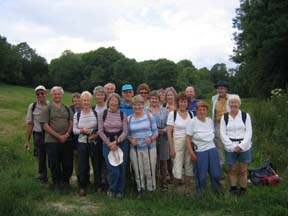
Descending off the Downs we crossed the A285 and climbed up again to near the top where we stopped for lunch. Then it was up again through a wheat field, passing the highest point on the Downs to our left. A rather lonely trig point stood in the middle of a field to our left as we progressed towards the end. A timber yard and a travellers tap showed we were almost there and so to the A286 and the end. A few of us walked the half mile into Cocking for a cream tea before the mini bus picked up to return home.
Tuesday 13 July 2003
From the car park at Cocking we set off up the hill to the top of Cocking Down, a steep
climb between fields of broad beans. The climb stretched the group out as the slower walkers
took their time to get to the top. With the Way running across the top of the Downs, the views
were wonderful including Chichester Cathedral to the south east. We stopped for coffee where
there were tree trunks laying on the ground so we had somewhere to sit and were rewarded with
the scent and sight of wild marjoram and thyme.
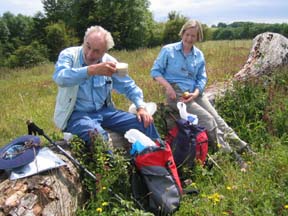
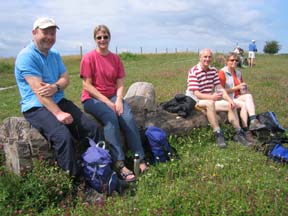
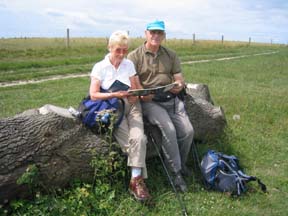
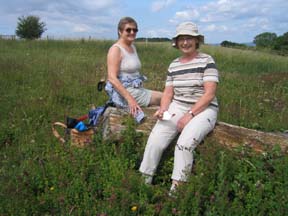
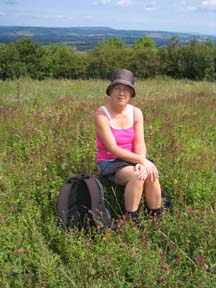
After a while we were in woodlands and came across the memorial to the German pilot killed in World War Two. We were delighted to see a male Purple Emperor butterfly with its iridescent purple wings glinting in the sun light. We descended towards Buriton Farm and some missed the turn to the right since the way mark was obscured by the hedge. Once we had put that right, it was a steady climb into woods and then a steeper climb up Pen Hill.
The Way skirts round the bottom of Beacon Hill before climbing up to Harting Down where we had lunch and met up with Bert who was providing some of the transport for the day. The views down to Harting with its copper spired church were beautiful. Leaving through the woods, we emerged onto a long, wide track which headed westwards. We crossed the boundary into Hampshire (where the SDW ended until 1989). After a while we realised we had hit the school run since the track was full of cars, first coming from behind us and then returning full of children. Turning off the track the way undulated through woods to the car park at Buriton. Since we were early, we made our way down to Buriton village for refreshments and to wait for the minibus.
Thursday 15 July 2004
After a day off yesterday, we were back on the track today, starting at Buriton. After a short walk we entered Queen Elizabeth Country Park, where at times the way marking was unclear. However, we found our way to the visitor centre where we took our coffee break. One walker even ordered a venison burger for his lunch which he wrapped and took with him. It was then under the A3 and so to the long climb to the top of Butser Hill. The maps show this as being higher than Tegleaze Crown which the guidebook reported as being the highest point on the Downs and was so noted on our Monday walk. This was one of many inconsistencies in the guide books we found. The Way follows the road for a while and soon comes to what appears to be the deserted HMS Mercury, a naval centre. A long track led to Salt Hill with views to East Meon. After lunch we came across a sign showing Eastbourne one way and Winchester the other.
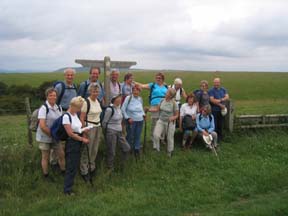
At the end of a farm track, the Way went through a gate to a field. However, a herd of cows standing at the gate blocked our path and did not seem prepared to move out of the way. Some loud hand clapping and shouting by Gordon finally got them out of the way and after a steep climb we came to Old Winchester Hill, a beautiful nature reserve where we enjoyed grassy paths, a wide range of butterflies, and many different flowers, including orchids. We passed over the Iron Age fort with views across all the surrounding countryside. Within the Hill Fort there was a plaque showing things that could be seen at all points of the compas.
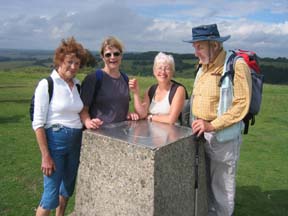
We turned off the Way along a disused railway line to Meonstoke for our overnight lodgings. The local pub was our venue for an evening meal together, where apart from the spilt red wine and coffee, a most enjoyable evening was had by all.
Friday 16 July 2004
We returned to the SDW by walking back up the disused railway and so come into Exton. What a village! A field of wild flowers stopped us in our tracks by its beauty.
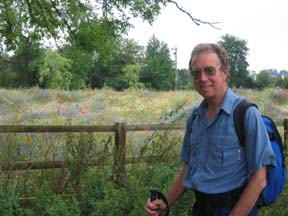
Then as we moved on, saw houses and gardens which were picture perfect. On leaving Exton, we were faced with a steep climb with nine stiles. It was hot and humid as we climbed up and climbed over. We stopped to take a drink at the top.
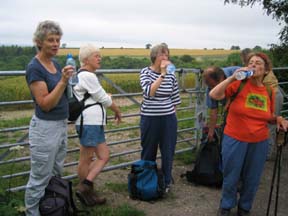
Just after our coffee break, the Wayfarer's Walk joined the South Downs Way. After a flat section we joined a road, passing the Fox and Hounds. When we came to the gentle climb to Gander Down, we stopped for a quick lunch before pressing on. Once past Chilcomb it was across fields to the bridge over the M4 and so into Winchester. The final approach through the gardens beside the river and beneath the town walls was a delightful way to approach our end. Turning out of the gardens we saw our final destination, King Alfred's statue. After a quick photo it was off to find a tea room and then catch the coach back to Lewes with other members of the group who had used the coach to come to Winchester.
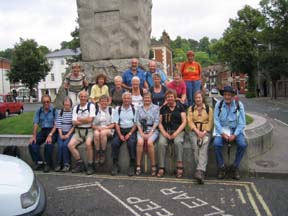
The final 18 walkers who made it were Brian, Ursula, Ray, Roy, Elisabeth, Grace, Graham, Joan and Eddie together with those who completed the entire walk from Eastbourne to Winchester - Jill, Janet, Gordon, Eileen, Joan, Mary, Ann, Helen and Gill. Our thanks to Jill and Janet who arranged it all so well despite setbacks, and to the drivers who ferried us around, particularly Bert. I wonder where we will go next year.
Monday 7 July 2003
Today saw the start of the group walking the South Downs Way from Eastbourne to Winchester. This
year we are going from Eastbourne to Washington. Next summer its Washington to Winchester.
In bright sunshine we left the station and made our way along the sea front to the start of the
South Downs Way. Climbing steeply we reached to top and from then on we had wonderful views of the
sea. The ground underfoot was full of wild flowers, making the walking a delight. After a short
coffee break at Beachy Head, we followed the path past Belle Tout lighthouse which was moved 17
metres inland on 17 March 1999; at least one of the group walking today had seen the move take place.
We descended to Birling Gap where we had a picnic lunch in bright sunshine, sheltered by the wall.
It was then the Seven Sisters, with steep ups and steep downs, with the down parts testing the knees.
At the end of the Seven Sisters we headed off to the right to descend to Cuckmere Haven, following
the river as it meandered up to Exceat where we took a break and bought ice creams.
�
�We walked 12.5 miles, climbing a total of just over 2200 feet. Tomorrow we return to Alfriston to
start the second leg.
Tuesday 8 July 2003
16 members restarted the walk from where we had left off the afternoon before. From the bus
stop at Alfriston we walked to the Star Inn and turned right to head for the path we were looking for.
Climbing slowly, first on the road then joining the path, we ascended to the top of the Downs
for glorious views across to Caburn and beyond.
And so on to Southease Church with its round tower, across the road picking up the path
again as it wound its way down the valley before ascending fairly steeply to the top of
the Downs again. Passing above Rodmell we headed West, picking up the concrete way for what
seemed a long time before turning off right. The way became softer as we passed above Kingston
and headed almost to Woodingdean. Once again we passed cattle with young
calves, some of whom were probably no older than a day or so. A bull in the field was
more interested in the cows than in us. We finally turned towards our finishing point,
the bridge over the A27 and a bus back to Lewes.
We walked 14.5 miles, climbing a total of 1300 feet. Tomorrow we catch the bus back to walk to
Pyecombe.
Wednesday 9 July 2003
In warm sunshine, 17 members started today from the bridge over the A27 near the old Newmarket Inn.
Once on the north of the road we climbed steeply up the face of the Downs, pausing in shade at the
top to take a drink. Then it was on through woods and out in the open glare of the sun.
Fortunately, as we reached the higher ground a cool wind was felt, making the walking more
pleasant. A brief coffee stop was taken in the shade of a hedge before setting off again.
We walked 8.5 miles, climbing a total of 800 feet. Tomorrow we take cars to Pyecombe
for the walk to Upper Beeding.
Thursday 10 July 2003
Once again the sun shone as 21 of us set out from Pyecombe, having moved cars to the
end of the walk so as to bring people back at the end of the day. As usual we started the day
with a climb up the Downs (why are they not called the Ups?). This time it was Cow Down and
we went on to skirt just below the
top of West Hill and then eventually down to Saddlescombe. Crossing the road we climbed up again and
took our coffee break at the top where a lemon cake made by Mary was produced for Janet's
birthday. We all sang 'Happy Birthday' and Gill read a poem she had composed.
Janet cut the cake and we all enjoyed a piece.
Today we walked 7 miles and climbed about 450 feet. Tomorrow we complete this year's walk,
ending in Washington.
Friday 11 July 2003
16 of us set of from the car park at Lower Beeding, following the river for a short time,
admiring the flotilla of swans. Then it was a slow climb up the road and the path to
Annington Hill. A brief stop for coffee before moving on to look down on Steyning Bowl.
Lunch was taken at the Ring in the shade of the trees with wonderful views in all directions.
After lunch it was but a short walk to the car park at Washington where the walk and the week
finished.
Certificates were given to those that had completed the entire walk from Eastbourne to Washington.
A round cheers of for Jill and Janet who organised the whole event, then it was back for tea at
Gordon and Eileen's. A great week of walking which was well organised, had wonderful weather
and the only call on the first aid kit was for a safety pin to hold up a pair of shorts.
Today we walked 6.5 miles and ascended 725 feet. In total we have walked 49 miles and climbed
some 5500 feet.
The walkers during the week were Ann, Ann, Colin, Derek, Eileen, Elisabeth, Frank, Gill, Gordon,
Graham, Grace, Grace, Helen, Janet, Jean, Jill, Joan, June, Liz, Mary, Michael, Peter, Sue and Roy
Early in the walk on our last day we came across a sign which said 60 miles to Winchester and
40 miles to Eastbourne which reminded us that we had the rest of the walk to complete in 2004.
�
�
�
�
�
�
�
We followed the path as it undulated its way above Alciston and Firle, past the radio aerials until
we finally looked down on Southease church. We stopped here for lunch
�
We descended to the road, passing through a large herd of cattle with young calves, who largely
ignored us, to the Newhaven road. Crossing the road we went down the path towards the level
crossing. Just after crossing the railway, some took the opportunity to refill their water bottles
from a convenient tap, for it was a hot and humid day.
�
Past Blackcap on our right, then views of Plumpton College and the Weald stretching into
the distance. We passed a field of poppies, making a scarlet patch on the Downs
�
And so to Ditchling Beacon, where we had lunch in the shade of some hawthorn trees. A few
members could not resist buying an ice cream from the van in the car park. The path from
Ditchling Beacon is soft downland turf and a delight to walk on. We passed a dew pond full
of wildlife and a signpost which told us that Eastbourne was to the east and Winchester to
the west.
�
Continuing on we came to the Jack and Jill windmills where we turned left and then further
down the path, right, to pass through the golf course before coming to the A273 and into
Pyecombe where the walk terminated for the day. We caught a convenient bus first to
Brighton as route 770 and then on the same bus now trading as route 28, to Lewes.
�
At various times on this walk we met or were passed by cyclists. Our usual cry when walking down
a road or track is 'CAR', but today it was 'CYCLIST'.
We walked round the rim of Devil's Dyke and on past Fulking to Truleigh Hill for lunch.
From there it was an easy walk to Lower Beeding to collect the cars and return to Pyecombe
and hence to Lewes.
�
�
After a short while the track became soft downland turf and the walking was easier than
the chalk tracks strewn with flints. Just before Chanctonbury Ring we met other walkers
on holiday with Holiday Fellowship who expressed a desire to join the club, so details were
exchanged and we hope to see them some time in the future.